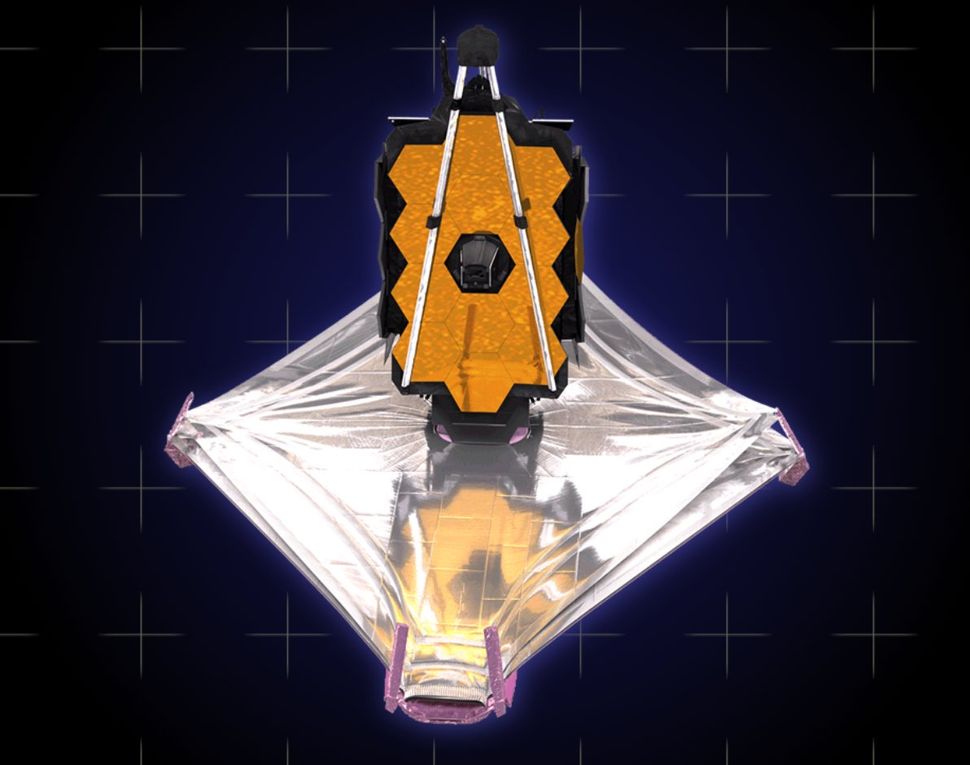Science
Related: About this forumJames Webb's sunshield extended to its full 47-foot width
By Georgina Torbet
January 1, 2022 8:08AM
Following a successful launch on Christmas day, the James Webb Space Telescope is currently heading through space, having traveled almost 500,000 miles from Earth. It is just over halfway to its eventual destination: The L2 orbit, called a Lagrange point, where it will move around the sun in a complex path. As James Webb travels it is slowly unfolding its various hardware which had to be folded up origami-style to fit into the Ariane 5 rocket which launched it.
The telescope is currently in the process of deploying its tennis court-sized sunshield — a complex operation of many steps which began earlier this week and is expected to take four to five days. This started with the deployment of structures called Pallet Structures, which hold the sunshield itself plus components like cables and pulleys. With the forward and aft pallet structures in place, the next step was deploying the Deployable Tower Assembly, a structure that creates space between the spacecraft and the telescope to make space for the sunshield. This deployment took place on Wednesday, December 29.
With that done, over Thursday and Friday this week the team deployment the aft moment flap to help maintain the telescope’s orientation once it is in orbit, and released the sunshield covers which protected the thin sunshield during launch.
The latest update from NASA is that James Webb has extended its two sunshield mid-booms. These “arms” extend to the left and right of the telescope, pulling the thin membrane of the sunshield with them until it spanned the full 47 feet of its width. Their deployment means that all of the 107 release devices for the various parts of the sunshield deployment have now been released.
More:
https://www.digitaltrends.com/news/james-webb-mid-boom-deployment/
Judi Lynn
(160,656 posts)By Meghan Bartels published about 4 hours ago

A graphic depicts the James Webb Space Telescope with its sunshield unfurled. (Image credit: NASA)
NASA personnel are spending the day studying the power subsystem of the massive James Webb Space Telescope to ensure the observatory is ready to execute a key procedure: tensioning its vast sunshield.
The Webb space telescope, which launched on Dec. 25, is conducting a month-long deployment procedure necessary to prepare the telescope to gather data. But most steps in that procedure are controlled from the ground: While NASA has a tentative schedule for the work, mission leaders can decide to adjust the timeline along the way. So after taking Saturday (Jan. 1) as a rest day, the Webb team is spending Sunday (Jan. 2) studying the observatory's power subsystem, NASA announced.
"Nothing we can learn from simulations on the ground is as good as analyzing the observatory when it's up and running," Bill Ochs, Webb project manager at NASA’s Goddard Space Flight Center (GSFC) in Maryland, said in an agency statement released Sunday (Jan. 2). "Now is the time to take the opportunity to learn everything we can about its baseline operations. Then we will take the next steps."
In particular, the team is focused on the temperature of a set of motors that will be used during sunshield tensioning, the process that separates and smooths the five delicate layers of the kite-shaped sun deflector. (Webb specializes in infrared observations, which are sensitive to heat, making the sunshield a vital component of the observatory.)
More:
https://www.space.com/james-webb-space-telescope-sunshield-tension-delay
WHITT
(2,868 posts)Cue Carly Simon's 'Anticipation'...
mitch96
(13,935 posts)Gore1FL
(21,164 posts)At least for those of us that won't look at the results and see giant conspiracy theories.
progree
(10,929 posts)Answer: 1 mile.
The distance between the earth and the sun is one astronomical unit (A.U.).
The closest star to Earth, other. than the sun, is Alpha Centauri at some 4.4 light-years away. Scaling the Earth-sun distance at one inch places this star at 4.4 miles (7 km) distant.
Scaling the astronomical unit at one inch (2.5 cm), here are distances to various bright stars, star clusters and galaxies:
The Sun: 1 inch (0.000025 km)
A light year: 1 mile (1.6 km)
Alpha Centauri: 4.4 miles (6.4 km)
Sirius: 8.6 miles (14 km)
Vega: 25 miles (40 km)
Pleiades open star cluster: 444 miles (715 km)
Antares: 555 miles (893 km)
Hercules globular star cluster (aka M13): 22,200 miles (35,700 km)
Center of our Milky Way galaxy: 26,100 miles (42,000 km)
Great Andromeda galaxy (M31): 2,540,000 miles (4,100,000 km)
....
https://earthsky.org/astronomy-essentials/how-far-is-a-light-year/
I know this isn't related to the OP but was trying to remember it as I read it.
Judi Lynn
(160,656 posts)progree
(10,929 posts)from me -- the IDS Tower in downtown Minneapolis -- and I remember that is the "distance" to Alpha Centauri, the nearest star. I think about that just about every time I go jogging.
But I keep forgetting the other part of it -- the earth-sun distance (astronomical unit) -- I think, is it an inch? naw, can't be. A foot? Yard?
Sciences is hard ![]()
3auld6phart
(1,055 posts)Mind boggling for sure. Thank you.![]()
endinequalitynow
(33 posts)Hopefully the success of the JWST will bring people together. I hope it will help us understand dark matter more. That will stimulate interest in STEM.